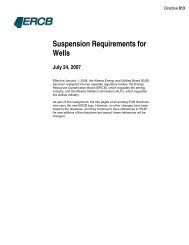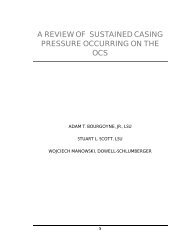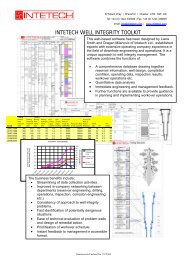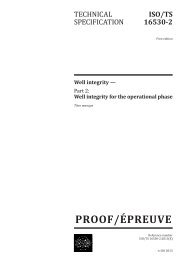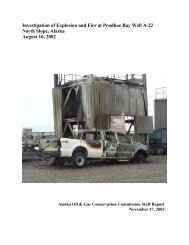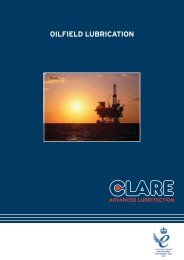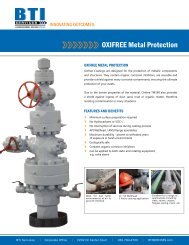Report Investigation of gas blowout on Snorre A - Well Integrity ...
Report Investigation of gas blowout on Snorre A - Well Integrity ...
Report Investigation of gas blowout on Snorre A - Well Integrity ...
Create successful ePaper yourself
Turn your PDF publications into a flip-book with our unique Google optimized e-Paper software.
7.4 Effect <str<strong>on</strong>g>of</str<strong>on</strong>g> reduced power supply<br />
The power supply was normal up until the Emergency Shut Down (ESD 2) was activated.<br />
The main power was stopped in c<strong>on</strong>necti<strong>on</strong> with the emergency shut down. The two<br />
emergency power generators started automatically. Main power amounts to a total <str<strong>on</strong>g>of</str<strong>on</strong>g> 82 MW<br />
(3 x 20 MW and a cable from <strong>Snorre</strong> B carrying 22 MW). After the emergency shut down,<br />
available power was supplied from two emergency generators, in a total amount <str<strong>on</strong>g>of</str<strong>on</strong>g> 4 MW.<br />
The cable from <strong>Snorre</strong> B was also disc<strong>on</strong>nected.<br />
This reducti<strong>on</strong> <str<strong>on</strong>g>of</str<strong>on</strong>g> power supply led to some practical problems, such as:<br />
• The capacity <str<strong>on</strong>g>of</str<strong>on</strong>g> the mud pumps was reduced to 1/6 <str<strong>on</strong>g>of</str<strong>on</strong>g> normal, and all operati<strong>on</strong>s in the<br />
drilling area took significantly l<strong>on</strong>ger than normal. This complicated implementati<strong>on</strong><br />
<str<strong>on</strong>g>of</str<strong>on</strong>g> an effective well c<strong>on</strong>trol operati<strong>on</strong>.<br />
• All ventilati<strong>on</strong> systems stopped.<br />
• Rooms protected with overpressure/underpressure lost their overpressure/<br />
underpressure. (In the event <str<strong>on</strong>g>of</str<strong>on</strong>g> <str<strong>on</strong>g>gas</str<strong>on</strong>g> outside such rooms, the equipment in the room is<br />
disc<strong>on</strong>nected).<br />
• Reducti<strong>on</strong> to <strong>on</strong>e air compressor powered by the emergency generators. In additi<strong>on</strong>,<br />
the emergency air compressor in Module D45 was started manually.<br />
Main power was restarted around midnight, which was c<strong>on</strong>sidered to be a risky operati<strong>on</strong>.<br />
After an overall evaluati<strong>on</strong>, including emphasis <strong>on</strong> the fact that no <str<strong>on</strong>g>gas</str<strong>on</strong>g> was detected <strong>on</strong> the<br />
facility after 2133 hours, the main power was restored. The following areas were then<br />
powered up:<br />
• Drilling area<br />
• Auxiliary equipment area<br />
• Living quarters module<br />
For the living quarters module, the air intake was turned so that it took in air above the ro<str<strong>on</strong>g>of</str<strong>on</strong>g> <str<strong>on</strong>g>of</str<strong>on</strong>g><br />
the living quarters module. In Uninterruptible Power Supply (UPS) room F11, recirculati<strong>on</strong><br />
<str<strong>on</strong>g>of</str<strong>on</strong>g> air was run in the room. The recirculati<strong>on</strong> system in the UPS room in F51 did not work.<br />
Here the doors were opened and pers<strong>on</strong>nel kept watch.<br />
7.5 Flaring and depressurizati<strong>on</strong><br />
The pipeline that leads the <str<strong>on</strong>g>gas</str<strong>on</strong>g> from the knock-out drum to the flare is purged with nitrogen<br />
during normal operati<strong>on</strong>s. This prevents air from entering the pipe and thus creating an<br />
explosive mixture <str<strong>on</strong>g>of</str<strong>on</strong>g> <str<strong>on</strong>g>gas</str<strong>on</strong>g>/air. Nitrogen is produced in a separate plant <strong>on</strong> the facility. In<br />
additi<strong>on</strong>, there is a pilot flame that burns c<strong>on</strong>tinuously at the top <str<strong>on</strong>g>of</str<strong>on</strong>g> the flare boom. This will<br />
ignite combustible <str<strong>on</strong>g>gas</str<strong>on</strong>g>es that might come out <str<strong>on</strong>g>of</str<strong>on</strong>g> the pipeline from the knock-out drum. This<br />
happens during situati<strong>on</strong>s such as depressurizati<strong>on</strong> <str<strong>on</strong>g>of</str<strong>on</strong>g> pipelines and the process plant.<br />
In this incident, depressurizati<strong>on</strong> <str<strong>on</strong>g>of</str<strong>on</strong>g> the <str<strong>on</strong>g>gas</str<strong>on</strong>g> compressors started automatically when PAS 3.4<br />
was triggered at 1935 hours. Manual depressurizati<strong>on</strong> was implemented 25 minutes after<br />
NAS 2 was activated at 2150 hours.<br />
The flare could not be extinguished, because there was not enough nitrogen <strong>on</strong> board. There<br />
was some nitrogen to extinguish the flame, but not enough to cool the tip <str<strong>on</strong>g>of</str<strong>on</strong>g> the flare. This<br />
would have led to immediate self-igniti<strong>on</strong> when HC <str<strong>on</strong>g>gas</str<strong>on</strong>g>es again moved up the flare. It took a<br />
45



